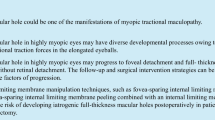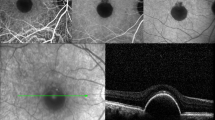Abstract
Purpose
To evaluate whether internal limiting membrane (ILM) peeling during vitrectomy affects vision outcome in patients with diabetic macular edema.
Material and method
Fifty-eight eyes of 49 patients were included in the study. Patients with persistent diffuse clinically significant macular edema were divided into two groups according to the surgical method used. Group I subjects (15 patients; mean age 56.60±8.50 years; 17 eyes total) underwent vitrectomy with ILM peeling. Group II subjects (34 patients; mean age 57.52±11.54 years; 41 eyes total) underwent vitrectomy without ILM peeling. The data recorded for each case were type and duration of diabetes, insulin treatment (yes/no), presence of arterial hypertension, stage of diabetic retinopathy, lens status, history of macular laser treatment, and detection of posterior vitreous detachment during surgery. Visual acuity was measured preoperatively and 1 year postoperatively in decimal notation, and values were converted to logarithm of minimal-angle-of-resolution (logMAR) scores. Mean pre- and postoperative visual acuity were compared within each group, and the mean change in visual acuity in Group I was compared to that in Group II.
Results
There were no significant differences between the groups with respect to age; sex distribution; diabetes type; duration of diabetes; numbers of patients on insulin treatment; frequencies of hypertension, proliferative diabetic retinopathy, previous macular laser treatment; or frequency of intraoperatively confirmed posterior vitreous detachment (chi-square, P>0.05 for all). Comparison of pre- and post-operative visual acuity revealed significant improvement in both Group I (1.15±0.307 vs. 0.764±0.355 logMAR, respectively; Wilcoxon rank test, P<0.01) and Group II (1.22±0.516 vs. 0.829±0.436 logMAR, respectively; Wilcoxon rank test, P<0.001). The change in visual acuity for Group I was not significantly different from that observed in Group II (0.391±0.335 vs. 0.393±0.273 logMAR, respectively; Mann–Whitney U test, P>0.05).
Conclusion
The visual acuity outcomes in the study indicate that vitrectomy without ILM peeling is just as effective as vitrectomy with ILM peeling in the treatment of diabetic macular edema. Both techniques led to significant and similar degrees of improvement in visual acuity.
Similar content being viewed by others
References
Early Treatment Diabetic Retinopathy Study Research Group. (1985) Number 1. Photocoagulation for diabetic macular edema. Arch Ophthalmol 103:1796–1806
Klein R, Klein BE, Moss SE, Cruickshanks KJ (1995) The Wisconsin epidemiologic study of diabetic retinopathy XV. The long-term incidence of macular edema. Ophthalmology 102(1):7–16
Moss S, Klein R, Klein B (1988) The incidence of vision loss in a diabetic population. Ophthalmology 95:1340–1348
Schepens CL, Avila MP, Jakth AE, Trempe CL (1984) Role of the vitreous in cystoid macular edema. Sury Ophthalmol 28(suppl):499–504
Ikeda T, Sato K, Katano T, Hayashi Y (1999) Attached posterior hyaloid membrane and the pathogenesis of honeycombed cystoid macular edema in patients with diabetes. Am J Ophthalmol 127:478–479
Lewis H, Abrams GW, Blamenkranz MS, Campo RV (1992) Vitrectomy for diabetic macular traction and edema associated with posterior hyaloidal traction. Ophthalmology 99:753–759
Funatsu H, Yamashita H, Noma H, Mımura T, Yamashita T, Hori S (2002) Increased levels of vascular endothelial growth factor and interleukin-6 in the aqueous humor of diabetics with macular edema. Am J Ophthalmol 133(1):70–77
The Diabetes Control and Complications Trial Research Group (1995) The effect of intensive diabetes therapy on the development and progression of diabetic retinopathy in insulin dependent diabetes mellitus. Arch Ophthalmol 113:36–51
The Diabetes Control and Complications Trial Research Group (1995) Progression of retinopathy with intensive versus conventional treatment in the diabetes control and complications trial. Ophthalmology 102:647–661
The Diabetes Control and Complications Trial Research Group (1993) The effect of intensive treatment of diabetes on the development and progression of long-term complications in insulin dependent diabetes mellitus. N Engl J Med 329:977–986
Early Treatment Diabetic Retinopathy Study Research Group (1995) Number 19. Focal photocoagulation treatment of diabetic macular edema. Relationship of treatment effect to fluorescein angiographic and other retinal characteristics at baseline. Arch Ophthalmol 113(9):1114–1115
Early Treatment Diabetic Retinopathy Study Research Group. (1991) Number 9. Early photocoagulation for diabetic retinopathy. Ophthalmology 98:766–785
Harbour JW, Smiddy WE, Flynn HW Jr, Rubsamen PE (1996) Vitrectomy for diabetic macular edema associated with a thickened and taut posterior hyaloid membrane. Am J Ophthalmol 121:405–413
Tachi N, Ogino N (1996) Vitrectomy for diffuse macular edema in cases of diabetic retinopathy. Am J Ophthalmol 122:258–260
Mester V, Kuhn F (2000) Internal limiting membrane removal in the management of full thickness macular holes. Am J Ophthalmol 129:769–777
Park DW, Sipperley JO, Sneed SR, Dugel PU, Jacobsen J (1999) Macular hole surgery with internal limiting membrane peeling and intravitrous air. Ophthalmology 106:1392–1397
Gandorfer A, Messmer EM, Ulbig MW, Kampik A (2000) Resolution of diabetic macular edema after surgical removal of the posterior hyaloid and the inner limiting membrane. Retina 20:126–133
Stitt AW, Moore JE, Sharkey JA et al (1998) Advanced glycation end products in vitreous: structural and functional implications for diabetic vitreopathy. Invest Ophthalmol Vis sci 39:2517–2523
Kohno T, Sorgente N, Ishibasbi T et al (1987) Immunofluorescent studies of fibronectin and laminin in human eye. Invest Ophthalmol Vis Sci 28:506–514
Yamamoto T, Akabane N, Takeuchi S (2001) Vitrectomy for diabetic macular edema: the role of posterior vitreous detachment and epimacular membrane. Am J Ophthalmol 132:369–377
Kishi S, Shimizu K (1990) Posterior vitreous precortical pocket. Arch Ophthalmol 108:979–982
Kishi S, Demaria C, Shimuzu K (1986) Vitreous cortex remnants at the fovea after spontaneous vitreous detachment. Int Ophthalmol 9:253–260
Stefanioutu M, Aspiotis M, Kalogeroploulos C, Christodoulou A, Psylla M, Ioachim E, Alamanos I, Psilas K (2004) Vitrectomy results for diffuse diabetic macular edema with and without inner limiting membrane removal. Eur J Ophthalmol 14:137–143
Yamamoto T, Hitani K, Sato Y, Yamashita H, Takeuchi S (2005) Vitrectomy for diabetic macular edema with and without internal limiting membrane removal. Ophthalmologica 218:206–213
Kamura Y, Sato Y, Isomae T, Shimada H (2005) Effects of internal limiting membrane peeling in vitrectomy on diabetic cystoid macular edema patients. Jpn J Ophthalmol 49:297–300
Sonoda KH, Sakamoto T, Enaida H et al (2004) Residual vitreous cortex after surgical posterior vitreous separation visualized by intravitreus triamcinolone acetonite. Ophthalmology 111:226–230
Yamamoto T, Hitani K, Tsukahara I et al (2003) Early postoperative retinal thickness changes and complications after vitrectomy for diabetic macular edema. Am J Ophthalmol 135:14–19
Pendergast SD (1998) Vitrectomy for diabetic macular edema associated with a taut premacular posterior hyaloid. Curr Opin Ophthalmol 9:71–75
Author information
Authors and Affiliations
Corresponding author
Rights and permissions
About this article
Cite this article
Bahadır, M., Ertan, A. & Mertoğlu, Ö. Visual Acuity Comparison of Vitrectomy with and without Internal Limiting Membrane Removal in the Treatment of Diabetic Macular Edema. Int Ophthalmol 26, 3–8 (2005). https://doi.org/10.1007/s10792-006-0008-4
Received:
Accepted:
Published:
Issue Date:
DOI: https://doi.org/10.1007/s10792-006-0008-4




